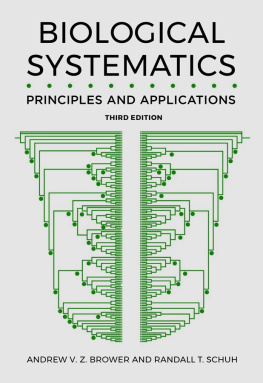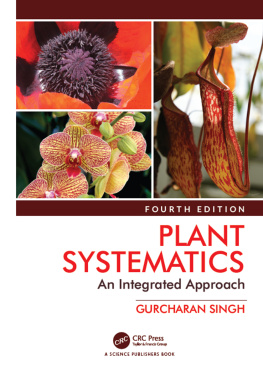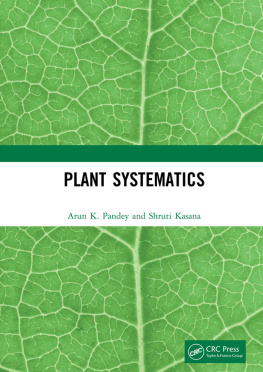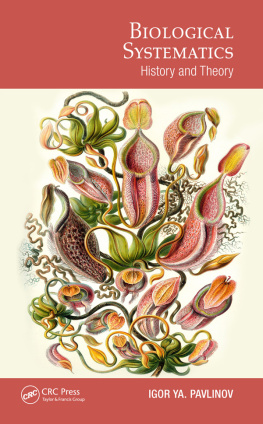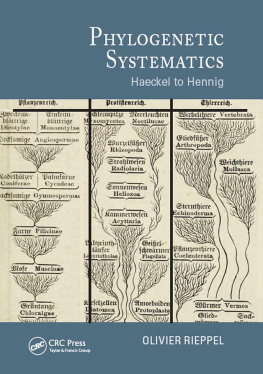Andrew V. Z. Brower - Biological Systematics: Principles and Applications
Here you can read online Andrew V. Z. Brower - Biological Systematics: Principles and Applications full text of the book (entire story) in english for free. Download pdf and epub, get meaning, cover and reviews about this ebook. year: 2021, publisher: Cornell University Press, genre: Romance novel. Description of the work, (preface) as well as reviews are available. Best literature library LitArk.com created for fans of good reading and offers a wide selection of genres:
Romance novel
Science fiction
Adventure
Detective
Science
History
Home and family
Prose
Art
Politics
Computer
Non-fiction
Religion
Business
Children
Humor
Choose a favorite category and find really read worthwhile books. Enjoy immersion in the world of imagination, feel the emotions of the characters or learn something new for yourself, make an fascinating discovery.
- Book:Biological Systematics: Principles and Applications
- Author:
- Publisher:Cornell University Press
- Genre:
- Year:2021
- Rating:5 / 5
- Favourites:Add to favourites
- Your mark:
- 100
- 1
- 2
- 3
- 4
- 5
Biological Systematics: Principles and Applications: summary, description and annotation
We offer to read an annotation, description, summary or preface (depends on what the author of the book "Biological Systematics: Principles and Applications" wrote himself). If you haven't found the necessary information about the book — write in the comments, we will try to find it.
Biological Systematics: Principles and Applications — read online for free the complete book (whole text) full work
Below is the text of the book, divided by pages. System saving the place of the last page read, allows you to conveniently read the book "Biological Systematics: Principles and Applications" online for free, without having to search again every time where you left off. Put a bookmark, and you can go to the page where you finished reading at any time.
Font size:
Interval:
Bookmark:

Copyright 2000, 2009, 2021 by Cornell University
All rights reserved. Except for brief quotations in a review, this book, or parts thereof, must not be reproduced in any form without permission in writing from the publisher. For information, address Cornell University Press, Sage House, 512 East State Street, Ithaca, New York 14850. Visit our website at cornellpress.cornell.edu.
First edition first published 2000 by Cornell University Press. Second edition 2009. Third edition 2021.
Library of Congress Cataloging-in-Publication Data
Names: Brower, Andrew V. Z. (Andrew Van Zandt), 1962 author. | Schuh, Randall T., author.
Title: Biological systematics : principles and applications / Andrew V. Z. Brower, Randall T. Schuh.
Description: 3rd edition. | Ithaca [New York] : Comstock Publishing Associates, an imprint of Cornell University Press, 2021. | Includes bibliographical references and index.
Identifiers: LCCN 2020028724 (print) | LCCN 2020028725 (ebook) | ISBN 9781501752773 (hardcover) | ISBN 9781501752780 (epub) | ISBN 9781501752797 (pdf)
Subjects: LCSH: BiologyClassification.
Classification: LCC QH83 .B76 2021 (print) | LCC QH83 (ebook) | DDC 578.01/2dc23
LC record available at https://lccn.loc.gov/2020028724
LC ebook record available at https://lccn.loc.gov/2020028725
All fields of science have undergone revolutions, and systematics is no exception. For example, the discovery of DNA structure fundamentally altered our conception of the mechanisms of inheritance. One might assume that the most recent revolution in systematic biology would have come about through the proposal of a coherent theory of organic evolution as the basis for recovering information on the hierarchic relationships observed among organisms. Such was not the case, however, no matter the frequency of such claims. Rather, it was the realization by Willi Hennigand othersnearly one hundred years after the publication of the Origin of Species by Charles Darwin, that homologies are transformed and nested, and that phylogenetic relationships can best be discovered through the application of what have subsequently come to be called cladistic methods. The fact that the theory of evolution allowed for the explanation of a hierarchy of descent was seemingly not sufficient to arrive at a method for consistent recovery of genealogical relationships. It can further be argued that neither was it necessary.
The revolutionary changes did not stop there, however. At the same time that the methods of cladistics were changing taxonomic practice on how to recognize natural groupings, the issue of quantification was being discussed with equal fervor. Whereas systematics was long a discipline marked by its strong qualitative aspect, the analysis of phylogenetic relationships is now largely quantitative.
The introduction of quantitative methods to systematics began with the numerical taxonomists. Their approach to grouping was based on overall similarity concepts, and the attendant assumption of equal rates of evolutionary change across phyletic lines. Establishment of systematic relationships is now dominated by cladistic methods, which form groups on the basis of special similarity and allow for unequal rates of evolutionary change. The logic and application of quantitative cladistics were in large part developed by James S. Farris.
The overall approach of this book is to present a coherent and logically consistent view of systematic theory founded on cladistic methodology and the principle of parsimony. Some of its subject matter is in a style that would commonly be found in research papers, that is, argument and critique. This approach allows material to be presented in its unadulterated form rather than in the abstract, such that sources of ideas at which criticism is being directed are not obscured and can be found readily in the primary literature. The tradition of critical texts in biological systematics was established by Blackwelder, Crowson, Hennig, Sokal and Sneath, and others. I hope that the style of this book will help students see argumentation in science for what it is, a way of developing knowledge and understanding ideas. The alternative would be to obscure historical fact by pretending that the formulation of a body of critical thought has proceeded in a linear fashion, without sometimes acrimonious debate.
Organization of the Text. This work is divided into three sections, representing more or less logical divisions of the subject matter. Section 1, Background for the Study of Systematics, comprises three chapters, which offer, respectively, an introduction to biological systematics, binominal nomenclature, and the philosophy of science as applied to systematics. Section 2, Cladistic Methods, outlines the methods of phylogenetic analysis, with chapters on homology and outgroup comparison, character analysis, computer-implemented phylogenetic analysis, and evaluation of phylogenetic results. Section 3, Application of Cladistic Results, comprises chapters on the preparation of formal classifications, historical biogeography and coevolution, testing evolutionary scenarios, and biodiversity and conservation. A terminal glossary provides definitions for the specialized terminology of systematics used in this book.
Each chapter ends with lists of Literature Cited and Suggested Readings. The references cited in the text are those actually needed to validate an argument, but do not in all cases necessarily represent the most useful available sources. The Suggested Readings are intended to augment the material presented in the text with more detailed knowledge to challenge the more sophisticated and inquiring student. The readings are chosen for their breadth and quality of coverage, with consideration also being given to their accessibility. Most should be available in major university libraries, and thus be readily available to most students and professors using this book.
R. T. Schuh, 2000
Nearly a decade has passed since the publication of the first edition of Biological Systematics. Computers have become faster, phylogenetic data matrices have become larger, and presentation of phylogenetic trees has become commonplace, even in literature outside the traditional realm of systematics. The exponential growth of DNA sequence data production has led to the emergence of the new disciplines of genomics and bioinformatics. During this interval, however, the core principles of systematicsdiscovery and interpretation of characters, construction of data matrices, search for most parsimonious treeshave remained largely unaltered. Therefore, our revision incorporates philosophical and technical advances of the past ten years, but also elaborates and enhances with additional examples the ideas that have formed the basis of modern systematics since its origins nearly fifty years ago.
Although likelihood-based methods of phylogenetic inference have increased in popularity, perhaps due to their implementation in easy-to-use software packages, our book retains its cladistic emphasis. As we have each found in our respective empirical research on Hemiptera and Lepidoptera, the cladistic approach is the most transparent, flexible, and direct means to interpret patterns of character-state transformation as evidence of hierarchical relationships among taxa. The most vociferous advocates of alternative methods are not biologists, but statisticians and computer programmers. We have been accused of bias in our preference for cladistic methods over alternatives, but we thinkand endeavor to explain in the bookthat our methodological choices are based on a clear and objective understanding of the problem being addressed. Systematics is not just about tree-building algorithms; our book devotes just one of its ten chapters to that aspect of the discipline. It is, rather a world view, nothing less than a coherent approach for organizing and understanding information about the natural world. It is with that idea in mind that we have chosen our subject matter and organized our overall presentation.
Next pageFont size:
Interval:
Bookmark:
Similar books «Biological Systematics: Principles and Applications»
Look at similar books to Biological Systematics: Principles and Applications. We have selected literature similar in name and meaning in the hope of providing readers with more options to find new, interesting, not yet read works.
Discussion, reviews of the book Biological Systematics: Principles and Applications and just readers' own opinions. Leave your comments, write what you think about the work, its meaning or the main characters. Specify what exactly you liked and what you didn't like, and why you think so.

